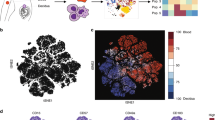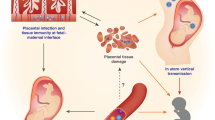Abstract
Human CD56bright NK cells accumulate in the maternal decidua during pregnancy and are found in direct contact with fetal trophoblasts. Several mechanisms have been proposed to explain the inability of NK cells to kill the semiallogeneic fetal cells. However, the actual functions of decidual NK (dNK) cells during pregnancy are mostly unknown. Here we show that dNK cells, but not peripheral blood–derived NK subsets, regulate trophoblast invasion both in vitro and in vivo by production of the interleukin-8 and interferon-inducible protein–10 chemokines. Furthermore, dNK cells are potent secretors of an array of angiogenic factors and induce vascular growth in the decidua. Notably, such functions are regulated by specific interactions between dNK-activating and dNK-inhibitory receptors and their ligands, uniquely expressed at the fetal-maternal interface. The overall results support a 'peaceful' model for reproductive immunology, in which elements of innate immunity have been incorporated in a constructive manner to support reproductive tissue development.
This is a preview of subscription content, access via your institution
Access options
Subscribe to this journal
Receive 12 print issues and online access
$209.00 per year
only $17.42 per issue
Buy this article
- Purchase on Springer Link
- Instant access to full article PDF
Prices may be subject to local taxes which are calculated during checkout






Similar content being viewed by others
Accession codes
References
Red-Horse, K. et al. Trophoblast differentiation during embryo implantation and formation of the maternal-fetal interface. J. Clin. Invest. 114, 744–754 (2004).
Zhou, Y. et al. Human cytotrophoblasts adopt a vascular phenotype as they differentiate. A strategy for successful endovascular invasion? J. Clin. Invest. 99, 2139–2151 (1997).
Zhou, Y., Genbacev, O., Damsky, C.H. & Fisher, S.J. Oxygen regulates human cytotrophoblast differentiation and invasion: implications for endovascular invasion in normal pregnancy and in pre-eclampsia. J. Reprod. Immunol. 39, 197–213 (1998).
Fisher, S.J. The placental problem: linking abnormal cytotrophoblast differentiation to the maternal symptoms of preeclampsia. Reprod. Biol. Endocrinol. 2, 53 (2004).
Hanna, J. et al. CXCL12 expression by invasive trophoblasts induces the specific migration of CD16– human natural killer cells. Blood 102, 1569–1577 (2003).
Drake, P.M. et al. Human placental cytotrophoblasts attract monocytes and CD56(bright) natural killer cells via the actions of monocyte inflammatory protein 1alpha. J. Exp. Med. 193, 1199–1212 (2001).
King, A. et al. Functions of human decidual NK cells. Am. J. Reprod. Immunol. 35, 258–260 (1996).
Koopman, L.A. et al. Human decidual natural killer cells are a unique NK cell subset with immunomodulatory potential. J. Exp. Med. 198, 1201–1212 (2003).
Cooper, M.A., Fehniger, T.A. & Caligiuri, M.A. The biology of human natural killer-cell subsets. Trends Immunol. 22, 633–640 (2001).
Hanna, J. et al. Novel insights on human NK cells' immunological modalities revealed by gene expression profiling. J. Immunol. 173, 6547–6563 (2004).
Bulmer, J.N. & Lash, G.E. Human uterine natural killer cells: a reappraisal. Mol. Immunol. 42, 511–521 (2005).
Tabiasco, J. et al. Human decidual NK cells: unique phenotype and functional properties – a review. Placenta 27 (Suppl. 1), 34–39 (2006).
Hanna, J. et al. Novel APC-like properties of human NK cells directly regulate T cell activation. J. Clin. Invest. 114, 1612–1623 (2004).
Leonard, S. et al. Mechanisms regulating immune cell contributions to spiral artery modification – facts and hypotheses – a review. Placenta 27 (Suppl. 1), 40–46 (2006).
Monk, J.M., Leonard, S., McBey, B.A. & Croy, B.A. Induction of murine spiral artery modification by recombinant human interferon-gamma. Placenta 26, 835–838 (2005).
Ashkar, A.A. & Croy, B.A. Functions of uterine natural killer cells are mediated by interferon gamma production during murine pregnancy. Semin. Immunol. 13, 235–241 (2001).
Ashkar, A.A., Di Santo, J.P. & Croy, B.A. Interferon γ contributes to initiation of uterine vascular modification, decidual integrity, and uterine natural killer cell maturation during normal murine pregnancy. J. Exp. Med. 192, 259–270 (2000).
Guimond, M.J. et al. Absence of natural killer cells during murine pregnancy is associated with reproductive compromise in TgE26 mice. Biol. Reprod. 56, 169–179 (1997).
Moffett, A. & Loke, Y.W. The immunological paradox of pregnancy: a reappraisal. Placenta 25, 1–8 (2004).
Hiby, S.E. et al. Combinations of maternal KIR and fetal HLA-C genes influence the risk of preeclampsia and reproductive success. J. Exp. Med. 200, 957–965 (2004).
Langer, N., Beach, D. & Lindenbaum, E.S. Novel hyperactive mitogen to endothelial cells: human decidual NKG5. Am. J. Reprod. Immunol. 42, 263–272 (1999).
Tjwa, M., Luttun, A., Autiero, M. & Carmeliet, P. VEGF and PlGF: two pleiotropic growth factors with distinct roles in development and homeostasis. Cell Tissue Res. 314, 5–14 (2003).
Goldman-Wohl, D.S., Ariel, I., Greenfield, C., Hanoch, J. & Yagel, S. HLA-G expression in extravillous trophoblasts is an intrinsic property of cell differentiation: a lesson learned from ectopic pregnancies. Mol. Hum. Reprod. 6, 535–540 (2000).
McMaster, M.T. et al. Human placental HLA-G expression is restricted to differentiated cytotrophoblasts. J. Immunol. 154, 3771–3778 (1995).
Corthay, A. et al. Primary antitumor immune response mediated by CD4+ T cells. Immunity 22, 371–383 (2005).
Zhang, L. et al. Wild-type p53 suppresses angiogenesis in human leiomyosarcoma and synovial sarcoma by transcriptional suppression of vascular endothelial growth factor expression. Cancer Res. 60, 3655–3661 (2000).
Katz, G. et al. MHC class I-independent recognition of NK-activating receptor KIR2DS4. J. Immunol. 173, 1819–1825 (2004).
Katz, G., Markel, G., Mizrahi, S., Arnon, T.I. & Mandelboim, O. Recognition of HLA-Cw4 but not HLA-Cw6 by the NK cell receptor killer cell Ig-like receptor two-domain short tail number 4. J. Immunol. 166, 7260–7267 (2001).
Gonen-Gross, T. et al. Complexes of HLA-G protein on the cell surface are important for leukocyte Ig-like receptor-1 function. J. Immunol. 171, 1343–1351 (2003).
Shiroishi, M. et al. Human inhibitory receptors Ig-like transcript 2 (ILT2) and ILT4 compete with CD8 for MHC class I binding and bind preferentially to HLA-G. Proc. Natl. Acad. Sci. USA 100, 8856–8861 (2003).
Moretta, A., Bottino, C., Mingari, M.C., Biassoni, R. & Moretta, L. What is a natural killer cell? Nat. Immunol. 3, 6–8 (2002).
Lanier, L.L. NKG2D in innate and adaptive immunity. Adv. Exp. Med. Biol. 560, 51–56 (2005).
Arnon, T.I. et al. Recognition of viral hemagglutinins by NKp44 but not by NKp30. Eur. J. Immunol. 31, 2680–2689 (2001).
Mandelboim, O. et al. Recognition of haemagglutinins on virus-infected cells by NKp46 activates lysis by human NK cells. Nature 409, 1055–1060 (2001).
Arnon, T.I. et al. Inhibition of the NKp30 activating receptor by pp65 of human cytomegalovirus. Nat. Immunol. 6, 515–523 (2005).
Kopcow, H.D. et al. Human decidual NK cells form immature activating synapses and are not cytotoxic. Proc. Natl. Acad. Sci. USA 102, 15563–15568 (2005).
Parham, P. NK cells and trophoblasts: partners in pregnancy. J. Exp. Med. 200, 951–955 (2004).
Li, X.F. et al. Angiogenic growth factor messenger ribonucleic acids in uterine natural killer cells. J. Clin. Endocrinol. Metab. 86, 1823–1834 (2001).
Trundley, A. & Moffett, A. Human uterine leukocytes and pregnancy. Tissue Antigens 63, 1–12 (2004).
Tayade, C., Black, G.P., Fang, Y. & Croy, B.A. Differential gene expression in endometrium, endometrial lymphocytes, and trophoblasts during successful and abortive embryo implantation. J. Immunol. 176, 148–156 (2006).
Henderson, T.A., Saunders, P.T., Moffett-King, A., Groome, N.P. & Critchley, H.O. Steroid receptor expression in uterine natural killer cells. J. Clin. Endocrinol. Metab. 88, 440–449 (2003).
Parham, P. Killer cell immunoglobulin-like receptor diversity: balancing signals in the natural killer cell response. Immunol. Lett. 92, 11–13 (2004).
Coudert, J.D. et al. Altered NKG2D function in NK cells induced by chronic exposure to NKG2D ligand-expressing tumor cells. Blood 106, 1711–1717 (2005).
Pazmany, L. et al. Human leucocyte antigen-G and its recognition by natural killer cells. J. Reprod. Immunol. 43, 127–137 (1999).
Kitaya, K. et al. IL-15 expression at human endometrium and decidua. Biol. Reprod. 63, 683–687 (2000).
Verma, S., Hiby, S.E., Loke, Y.W. & King, A. Human decidual natural killer cells express the receptor for and respond to the cytokine interleukin 15. Biol. Reprod. 62, 959–968 (2000).
Faust, Z., Laskarin, G., Rukavina, D. & Szekeres-Bartho, J. Progesterone-induced blocking factor inhibits degranulation of natural killer cells. Am. J. Reprod. Immunol. 42, 71–75 (1999).
Fehniger, T.A. et al. CD56bright natural killer cells are present in human lymph nodes and are activated by T cell-derived IL-2: a potential new link between adaptive and innate immunity. Blood 101, 3052–3057 (2003).
Rajagopalan, S. et al. Activation of NK cells by an endocytosed receptor for soluble HLA-G. PLoS Biol 4, e9 (2006).
Acknowledgements
We would like to thank O. Wald, N. Stern, G. Cohen, G. Katz, T. Gonen-Gross and S. Cohen for assistance. We would like to also thank I. Ariel and A. Peled for discussion. O.M. is supported by research grants from the Israel Cancer Research Foundation, The Israel Science Foundation, European Commission (QLK2-CT-2002-011112) and the Israeli Cancer Research Institute. S.Y. is supported by a grant from the Office of the Chief Scientist, Israel Ministry of Health (5695). J.H. is supported by fellowships from the Foulkes Foundation and Israeli Ministry of Education.
Author information
Authors and Affiliations
Contributions
J.H. conceived the idea for this project, designed all experiments, performed NK cell isolations, gene arrays and all in vitro and in vivo functional experiments. D.G.-W., Y.H., C.G., S.N.-Y. and S.Y. provided human tissue samples, performed trophoblast isolation and chemokine receptor immunohistochemistry. I.A. and E.K. provided technical assistance with angiogenesis assays. T.I.A. and A.P. provided soluble NK receptors. D.B. and V.Y. developed a protocol of affinity histochemistry with NCR-Fc reagents. D.P. confirmed pathology results. L.C.-D., R.G. and I.M. provided technical assistance with in vivo experiments. O.M. supervised the project, provided crucial ideas and helped with data interpretation. J.H. wrote the manuscript with O.M. and S.Y.
Corresponding authors
Ethics declarations
Competing interests
The authors declare no competing financial interests.
Supplementary information
Supplementary Fig. 1
Chemokine receptor expression on human invasive trophoblasts. (PDF 57 kb)
Supplementary Fig. 2
Characterization of dNK clones for LIR and KIR expression. (PDF 62 kb)
Supplementary Table 1
Average normalized values obtained from genearray analysis on human dNK cells. (XLS 2779 kb)
Supplementary Table 2
Transcription profile of selected chemokines and angiogenic factors in dNK cells revealed by microarray analysis. (PDF 68 kb)
Supplementary Table 3
Semiquantative RT-PCR analysis of chemokines in human dNK cells. (PDF 79 kb)
Supplementary Table 4
Chemokine receptor transcription on HLA-G+ purified human invasive decidual trophoblasts. (PDF 56 kb)
Rights and permissions
About this article
Cite this article
Hanna, J., Goldman-Wohl, D., Hamani, Y. et al. Decidual NK cells regulate key developmental processes at the human fetal-maternal interface. Nat Med 12, 1065–1074 (2006). https://doi.org/10.1038/nm1452
Received:
Accepted:
Published:
Issue Date:
DOI: https://doi.org/10.1038/nm1452
This article is cited by
-
Pregnancy, a test case for immunology
Synthese (2024)
-
The role of immune cells and mediators in preeclampsia
Nature Reviews Nephrology (2023)
-
The Role of Interferon (IFN)-γ in Extravillous Trophoblast Cell (EVT) Invasion and Preeclampsia Progression
Reproductive Sciences (2023)
-
Reactivation of natural killer cells with monoclonal antibodies in the microenvironment of malignant neoplasms
Journal of Cancer Research and Clinical Oncology (2023)
-
Activating NKG2C Receptor: Functional Characteristics and Current Strategies in Clinical Applications
Archivum Immunologiae et Therapiae Experimentalis (2023)



